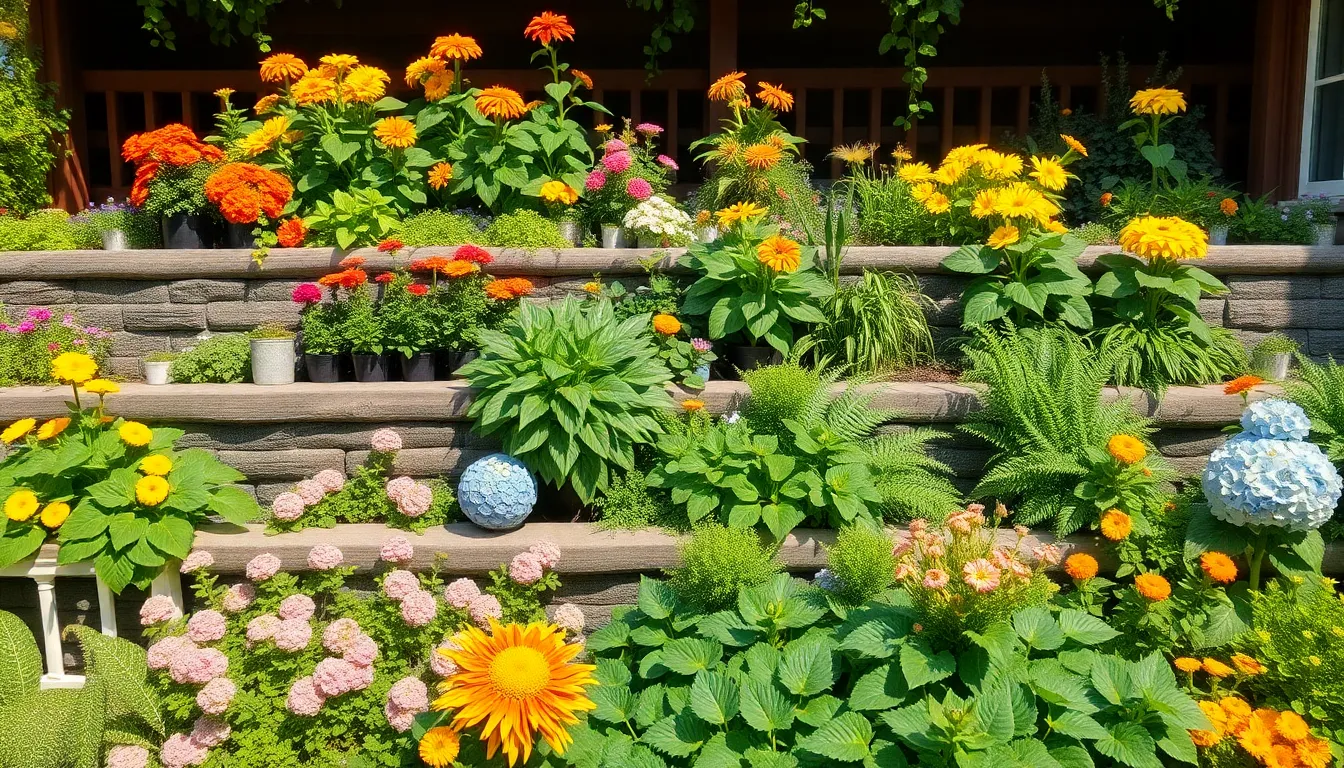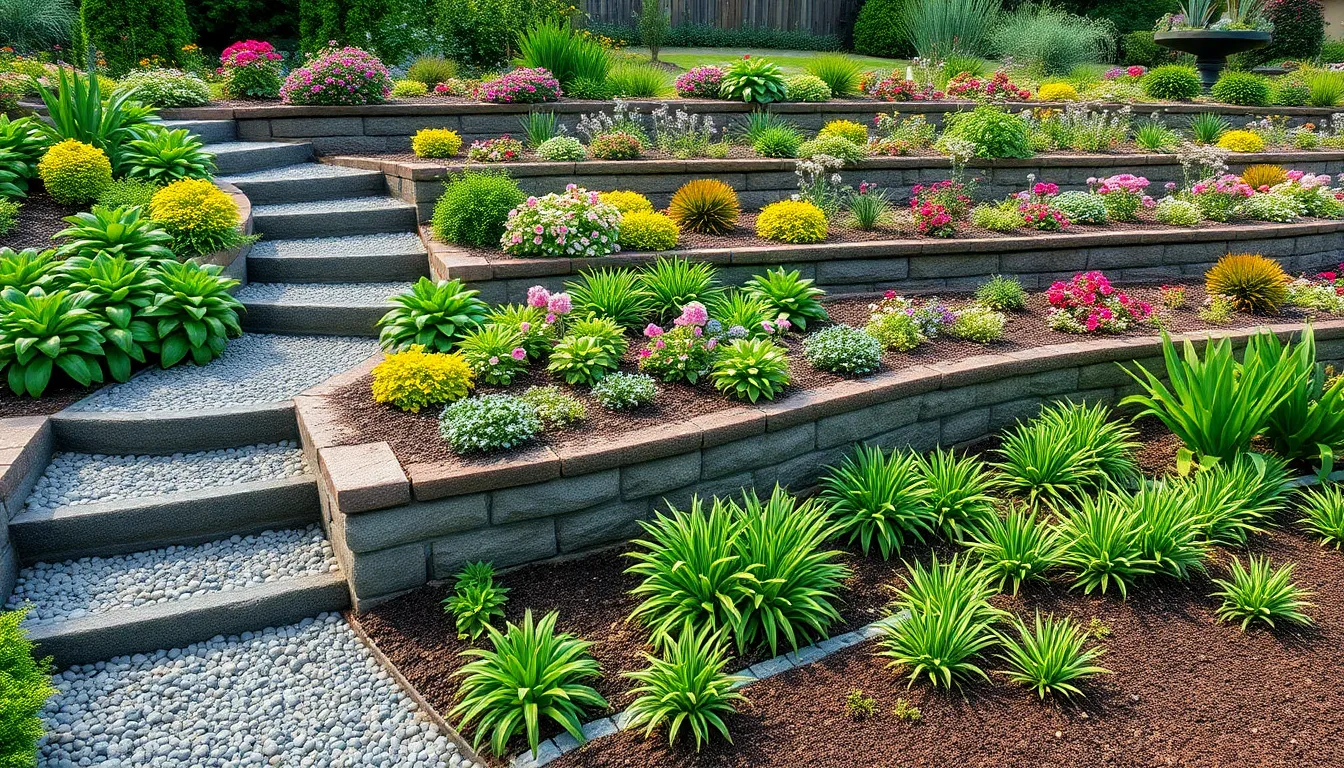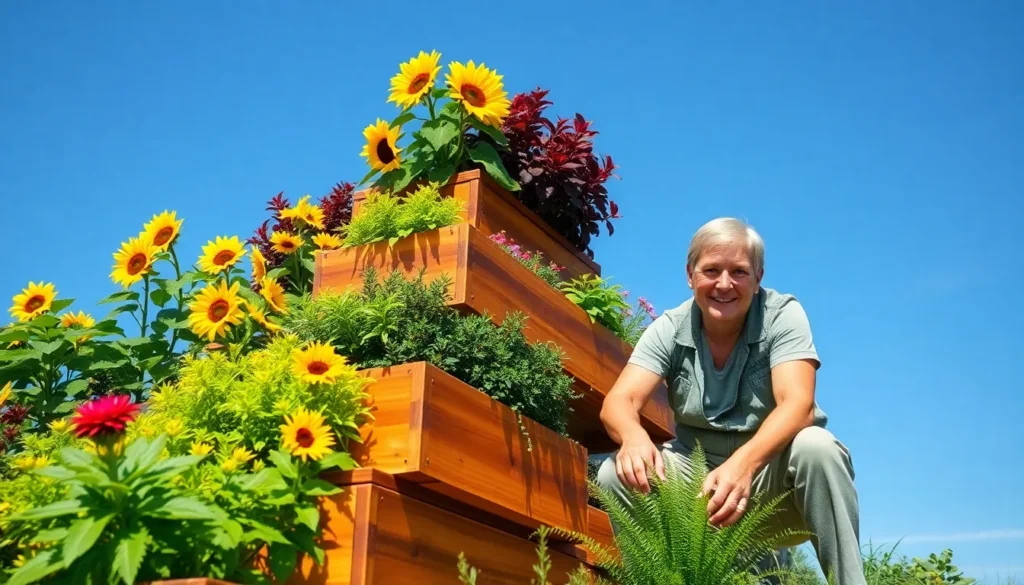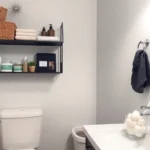Transforming a flat outdoor space into a stunning multi-dimensional industry doesn’t require professional landscaping skills or a massive budget. Tiered gardens offer an innovative solution that maximizes growing space while creating visual depth and natural beauty that’ll make your neighbors stop and stare.
We’ve discovered that layered gardening approaches work brilliantly for slopes, small yards, and even compact patios. Whether you’re dealing with challenging terrain or simply want to add architectural interest to your outdoor space, tiered designs let you grow more plants in less space while creating distinct zones for different purposes.
From simple raised bed arrangements to elaborate terraced hillsides, we’ll explore creative tiered garden concepts that transform ordinary yards into extraordinary outdoor sanctuaries. These versatile designs not only solve drainage issues and prevent soil erosion but also make maintenance easier by bringing plants to comfortable working heights.
Create Visual Drama With Multi-Level Raised Beds
Multi-level raised beds transform ordinary garden spaces into stunning focal points that command attention. These structured growing systems allow us to maximize planting area while creating dramatic height variations that make small gardens appear larger and more sophisticated.
Build Cascading Wooden Planters
Cascading wooden planters create natural stepping stone effects that guide the eye through your garden industry. We recommend using cedar or redwood for their weather resistance and attractive grain patterns that complement outdoor settings. Start with three different heights—typically 12, 18, and 24 inches—to establish clear visual separation between planting levels.
Position the tallest planter at the back and arrange shorter ones in descending order toward the front. This arrangement ensures adequate sunlight reaches all plants while creating depth perception. Connect each level with decorative stepping stones or small pathways to unify the design.
Build each frame using 2×8 or 2×10 boards with reinforced corner joints for long-term stability. We’ve found that adding horizontal support boards every 4 feet prevents bowing under soil weight. Fill each tier with quality potting mix and establish proper drainage by drilling holes every 6 inches along the bottom boards.
Design Stone Walled Garden Tiers
Stone walled garden tiers bring permanent elegance to outdoor spaces while providing excellent drainage and temperature regulation for plant roots. Natural fieldstone, limestone, or manufactured concrete blocks work well for this application. We typically build walls between 18 and 36 inches high to create comfortable working heights.
Start construction by excavating 4 to 6 inches below ground level for a stable foundation. Layer crushed gravel as the base before placing your first course of stones. Use a slight backward lean—approximately 1 inch for every foot of height—to ensure structural integrity as soil settles behind the wall.
Install drainage pipes behind each tier to prevent water buildup that could destabilize the structure. We recommend perforated drain tiles surrounded by gravel for optimal water management. Fill gaps between stones with smaller rocks rather than mortar to allow natural water filtration while maintaining wall flexibility during freeze-thaw cycles.
Install Metal Framed Growing Levels
Metal framed growing levels offer sleek, modern aesthetics with exceptional durability and precise geometric lines. Galvanized steel or powder-coated aluminum frames resist rust and maintain their appearance for decades with minimal maintenance. We prefer modular systems that allow easy reconfiguration as garden needs change.
Choose frames with heights of 8, 16, and 24 inches to create distinct planting zones for different crop types. Root vegetables thrive in deeper 24-inch frames while herbs and lettuce grow well in shallower 8-inch options. Position frames to create geometric patterns—squares, rectangles, or L-shapes—that complement your home’s architectural style.
Secure each frame level using ground anchors or concrete footings to prevent shifting during severe weather. We recommend adding corner braces for frames longer than 8 feet to maintain structural rigidity. Line the bottom with hardware cloth to prevent rodent intrusion while allowing proper drainage through the metal framework.
Maximize Small Spaces With Vertical Gardening Solutions

Vertical gardening transforms even the tiniest outdoor areas into productive growing spaces by utilizing walls and vertical structures rather than spreading horizontally. We can achieve remarkable plant diversity and visual impact by building upward instead of outward.
Construct Terraced Container Gardens
Stack containers of varying sizes to create multiple growing levels that add dimension and maximize planting space. Large containers work best as the foundation, while smaller pots can nest perfectly on top or alongside them. We recommend using lightweight materials like resin or fiberglass to reduce the overall weight load on your structure.
Position the largest containers at the base to create stability for your entire terraced system. Medium sized pots can be placed on sturdy platforms or plant stands to create the middle tier. Small containers and hanging baskets complete the upper levels, creating a cascading effect that draws the eye upward.
Drainage becomes critical in stacked container systems since water flows from upper containers to lower ones. Drill adequate drainage holes in each container and place saucers only under the bottom tier to catch excess water. We’ve found that using a drip irrigation system prevents overwatering while ensuring each level receives proper moisture.
Build Stair Step Planting Systems
Design tiered planters that resemble actual stairs to create easy access points while maximizing growing space. Cedar or redwood planters work exceptionally well for this application due to their natural weather resistance and attractive appearance. Each step should measure at least 8 inches deep to accommodate most plant root systems.
Construct your stair step system with progressively smaller tiers moving upward to create visual balance. The bottom step might measure 36 inches wide, the middle step 24 inches, and the top step 12 inches wide. This pyramid approach ensures structural stability while providing ample growing space at each level.
Install proper support brackets beneath each step to handle the weight of soil and fully grown plants. We recommend using galvanized steel brackets rated for outdoor use to prevent rust and ensure longevity. Space the steps 10 to 12 inches apart vertically to allow adequate sunlight to reach plants on lower tiers.
Create Hanging Tier Combinations
Suspend multiple planters at different heights to create a dramatic vertical garden display without using any floor space. Sturdy ceiling hooks or wall mounted brackets can support tiered hanging systems that accommodate herbs, succulents, and trailing plants. We suggest using lightweight hanging planters to reduce stress on mounting hardware.
Install your hanging tiers at staggered heights to prevent upper planters from blocking sunlight to lower ones. Position the highest tier at least 6 feet from the ground, with subsequent tiers dropping 12 to 18 inches lower. This spacing allows trailing plants to cascade naturally while maintaining access for maintenance.
Choose plants with similar water and light requirements for each hanging tier to simplify care routines. Herbs like oregano and thyme work well in upper tiers where they receive maximum sunlight. Shade tolerant plants such as begonias or impatiens thrive in lower hanging positions where they receive filtered light.
Transform Slopes Into Productive Growing Areas

Challenging slopes present unique opportunities for creating productive tiered gardens that maximize every inch of available space. We’ll explore practical methods to convert these difficult terrains into thriving growing areas.
Design Natural Hillside Terraces
Natural hillside terraces mimic traditional farming practices found in mountainous regions worldwide. We sculpt slopes into stepped horizontal platforms that follow organic contours and rely on plant roots for support. This eco-friendly approach decreases runoff by 40-60% compared to conventional sloped planting while fostering healthier soil conditions.
Building these terraces requires careful observation of your slope’s natural drainage patterns. We recommend starting at the bottom and working upward, creating platforms that are 3-4 feet wide for optimal planting space. Each terrace should have a slight backward slope of 2-3 degrees to encourage water infiltration rather than runoff.
Native grasses and groundcover plants serve as excellent natural retaining elements for these terraces. We plant these stabilizing species along the edges first, allowing their root systems to establish before adding vegetables or flowers to the flat growing areas. This method supports crop rotation and companion planting across different levels.
Build Retaining Wall Garden Beds
Retaining wall garden beds use durable materials like pressure-treated wood sleepers, natural stones, or bricks to create elevated planting zones. We build these structures to stabilize slopes while defining clear planting areas that can last for decades with proper construction.
Pressure-treated lumber offers the most cost-effective option, with 6×6 inch timbers providing excellent stability for walls up to 3 feet high. We anchor these timbers using rebar stakes driven 18-24 inches into the ground, ensuring the wall can withstand soil pressure and seasonal freeze-thaw cycles.
Stone walls provide superior longevity and natural aesthetics but require more technical skill to construct properly. We recommend using locally sourced fieldstone or limestone blocks, building walls with a slight backward lean of 1 inch per foot of height. Proper drainage behind stone walls prevents water buildup that could cause structural failure.
Matching materials between walls and pathways creates visual cohesion throughout the tiered garden. We often use the same stone or timber for steps and borders, improving the overall design while maintaining practical functionality.
Install Stepped Stone Gardens
Stepped stone gardens combine functionality with visual appeal by creating durable pathways that connect different garden levels. We construct these systems using natural stone or concrete pavers that descend or ascend with the slope’s natural grade.
Flagstone and bluestone work exceptionally well for these installations due to their natural slip resistance and drainage properties. We typically space stones 12-18 inches apart to accommodate comfortable walking while allowing plants to grow between the gaps. This spacing also improves drainage and reduces the risk of water pooling during heavy rains.
Installation begins with proper excavation and base preparation using crushed gravel for stability. We level each stone individually, ensuring consistent rise heights of 6-8 inches between levels for safe navigation. Sand or stone dust fills gaps between pavers, creating a stable walking surface that allows water infiltration.
Plant selection between stone steps focuses on low-growing, drought-tolerant varieties like creeping thyme, sedum, or moss. We choose plants that can withstand occasional foot traffic while adding color and texture to the stone surfaces. These plantings also help prevent weed growth and add natural beauty to the utilitarian pathways.
Choose the Right Plants for Each Garden Level

Understanding the microclimates within your tiered garden ensures optimal plant placement and thriving vegetation. Different levels create unique growing conditions that we can leverage for exact plant varieties.
Select Sun-Loving Plants for Upper Tiers
Upper tiers typically receive more sunlight, making them perfect locations for plants that crave direct solar exposure. We recommend positioning lavender, rosemary, and sunflowers on these elevated areas where they’ll flourish in full sun conditions.
Mediterranean herbs thrive exceptionally well on upper levels, including oregano, thyme, and sage. These drought-tolerant plants handle the increased heat and wind exposure that comes with elevation.
Flowering plants like marigolds, zinnias, and cosmos add vibrant color to your highest garden tiers. Their sun-loving nature ensures abundant blooms throughout the growing season when positioned correctly.
Succulents and cacti collections create stunning displays on upper levels where drainage naturally improves. Species like sedums, echeveria, and barrel cacti appreciate the enhanced air circulation and reduced moisture retention.
Pick Moisture-Loving Varieties for Lower Levels
Lower levels often retain more moisture, creating ideal conditions for plants that prefer consistent soil hydration. We suggest planting ferns, hostas, and hydrangeas in these naturally damper areas of your tiered garden.
Shade-tolerant perennials perform beautifully in lower garden sections where water collects naturally. Astilbe, heuchera, and coral bells thrive in these protected environments with filtered sunlight.
Woodland plants like trilliums, wild gingers, and solomon’s seal establish easily in lower tier locations. These native species appreciate the cooler, moister conditions that develop at ground level.
Bog plants and water-loving vegetables find perfect homes in lower garden areas. Plants such as watercress, mint, and Japanese iris flourish where soil stays consistently moist without becoming waterlogged.
Plan Companion Planting Across Tiers
Companion planting across different levels maximizes growing efficiency while creating beneficial plant relationships throughout your tiered garden system. We recommend pairing marigolds with tomatoes across multiple tiers to naturally deter pests and improve flavor.
Vertical companion relationships work exceptionally well in tiered designs, allowing taller plants on upper levels to provide shade for heat-sensitive crops below. Corn planted on higher tiers can shelter lettuce and spinach growing on lower levels.
Nitrogen-fixing plants on upper tiers benefit lower-level heavy feeders through natural nutrient cycling. Legumes like beans and peas planted above can improve soil conditions for brassicas and nightshades positioned below.
Aromatic herbs distributed across different tiers create pest-deterrent zones throughout your garden. Basil, chives, and garlic planted strategically across levels provide natural protection while maximizing space utilization for productive growing.
Implement Efficient Watering Systems for Tiered Gardens

Water management becomes crucial when creating tiered gardens, as gravity naturally pulls moisture downward through multiple levels. We’ll explore three proven irrigation answers that optimize water distribution while reducing waste and maintenance time.
Install Drip Irrigation Networks
Drip irrigation delivers water directly to plant roots, making it particularly effective for tiered gardens where water distribution can be uneven. We recommend installing dedicated drip lines for each tier level, allowing customized flow rates based on plant needs and soil conditions.
Setting up the system requires running a main water line to the highest tier, then branching secondary lines to lower levels. Place emitters strategically near plant root zones, spacing them 12 to 18 inches apart for vegetables and 18 to 24 inches for larger shrubs. This targeted approach reduces evaporation by up to 50% compared to traditional sprinkler systems.
Installation involves connecting pressure compensating emitters to ensure consistent water flow across all tiers. We suggest using timer controlled valves to automate watering schedules, delivering water during early morning hours when evaporation rates are lowest. The system works exceptionally well with pressure treated softwood sleeper tiers, where consistent moisture distribution prevents uneven plant growth.
Create Gravity-Fed Water Features
Gravity fed water features enhance aesthetic appeal while distributing water naturally through tiered garden levels. We can incorporate small cascades between tiers that serve dual purposes: creating visual interest and providing gentle irrigation to lower planting areas.
Designing these features starts with installing a reservoir at the highest point, allowing water to flow downward through decorative channels or subtle waterfalls. Stone lined channels work particularly well, directing overflow water to exact planting zones while preventing erosion between tiers. The flowing water creates a soothing sound while delivering moisture where it’s needed most.
Recirculating pump systems make these features sustainable by collecting water at the bottom tier and pumping it back to the top reservoir. We recommend incorporating shallow collection basins at each level to capture excess water, preventing waste while maintaining consistent soil moisture. These systems complement contemporary landscaping designs with grey wooden decking and LED lighting, adding movement and sparkle to modern tiered gardens.
Design Self-Watering Tier Systems
Self watering systems integrate water storage directly into each tier, releasing moisture as plants need it while reducing manual watering frequency. We can build these systems using double walled planters with water reservoirs beneath the growing medium, creating consistent moisture levels without overwatering.
Construction involves creating a false bottom in each tier with drainage pipes connecting to a central water reservoir. Wicking materials like cotton rope or specially designed fabric draw water upward into the soil as it dries out. This method works exceptionally well for vegetable gardens and annual flowers that require consistent moisture levels.
Smart sensors can enhance these systems by monitoring soil moisture and automatically refilling reservoirs when needed. We suggest installing overflow drains at each level to prevent waterlogging during heavy rainfall periods. The combination of gravity fed distribution and self regulating moisture release creates an efficient watering network that maintains optimal growing conditions across all garden tiers.
Build Budget-Friendly DIY Tiered Garden Structures

Creating beautiful tiered gardens doesn’t require expensive materials or professional contractors. We can transform our outdoor spaces using affordable, readily available materials that deliver stunning results.
Repurpose Pallets for Garden Tiers
Pallets offer one of the most cost-effective answers for building garden tiers. We can easily dismantle these wooden structures to create flat planting surfaces and stack them at different heights. Securing each tier with screws or nails ensures stability while creating distinct growing levels.
These versatile materials work perfectly for herb gardens, flower displays, or vegetable patches. We’ll find that pallet tiers provide excellent drainage when we leave gaps between the wooden slats. Most pallets are available for free from local businesses, making this an incredibly budget-friendly option for our tiered garden projects.
Use Cinder Blocks for Affordable Levels
Cinder blocks provide durable, stackable building materials for creating terraced garden walls and levels. We can arrange these concrete blocks to form retaining walls that define our planting areas while supporting soil on slopes. The hollow centers of cinder blocks offer additional planting opportunities for trailing herbs or compact flowers.
Stacking cinder blocks requires no mortar for low tiers, though we should use construction adhesive for taller structures. We can fill the gaps between blocks with colorful flowers or cascading plants to soften the industrial appearance. This method costs significantly less than traditional stone walls while providing excellent structural support.
Create Tire Planter Pyramids
Old tires make excellent planters when stacked to form pyramid-shaped garden tiers. We can arrange tires of different sizes with the largest at the bottom, creating natural drainage layers as water flows from upper to lower levels. Each tire holds substantial amounts of soil, perfect for vegetables, flowers, or herbs.
Painting tires with outdoor paint transforms their appearance and helps them blend with our garden aesthetic. We should drill drainage holes in the bottom of each tire to prevent waterlogging. This recycling approach costs almost nothing while creating eye-catching vertical garden displays that maximize our growing space.
Maintain Your Tiered Garden Throughout the Seasons

Successful tiered gardens require consistent care and attention to thrive year after year. We’ll explore essential maintenance strategies that keep your multi-level garden healthy and productive through every season.
Establish Proper Drainage Systems
Drainage systems form the foundation of any successful tiered garden maintenance plan. Each tier needs adequate water movement to prevent accumulation that can damage plant roots and compromise structural integrity.
Installing French drains provides the most effective solution for managing water flow between garden levels. We recommend positioning these drainage systems at the base of each retaining wall to capture excess moisture. Permeable materials like gravel or crushed stone create natural pathways for water movement while maintaining soil stability.
Monitor drainage performance during heavy rainfall seasons to identify potential problem areas. Signs of poor drainage include standing water, soggy soil conditions, and plant stress in lower tiers. Address these issues immediately by adding drainage pipes or creating additional water outlets.
Consider installing drainage tiles beneath raised bed structures to direct water away from plant roots. These systems work particularly well in clay soil conditions where natural drainage proves challenging.
Plan Seasonal Plant Rotations
Plant rotations maximize growing potential across all garden tiers while maintaining soil health throughout the year. We suggest creating a rotation schedule that moves plants between different levels based on their seasonal needs and growth patterns.
Spring rotations should focus on moving cool season crops like lettuce and peas to upper tiers where they receive optimal morning sun. Summer transitions call for relocating heat sensitive plants to lower levels where they benefit from afternoon shade and increased moisture retention.
Document plant performance at each tier level to identify optimal growing zones for exact varieties. This information helps create more effective rotation patterns that boost overall garden productivity. Keep detailed records of which plants thrive at exact elevations and microclimates within your tiered system.
Fall preparations involve moving perennial plants to protected positions and establishing winter cover crops on empty tiers. These cover crops prevent soil erosion while adding organic matter for the following growing season.
Prevent Soil Erosion Issues
Soil erosion threatens the structural integrity of tiered gardens and requires proactive prevention strategies. Tiered landscaping naturally creates barriers that slow water movement, but additional measures ensure long term stability.
Plant selection plays a crucial role in erosion control across garden levels. We recommend establishing groundcover plants that require only annual trimming while providing year round soil stabilization. These low maintenance options include creeping thyme, vinca, and pachysandra that spread naturally to cover exposed soil areas.
Retaining walls serve as primary erosion barriers but need regular inspection for signs of movement or damage. Check wall stability after heavy storms and freeze thaw cycles that can compromise structural integrity. Address small issues immediately before they develop into major problems requiring complete reconstruction.
Mulching exposed soil surfaces provides immediate erosion protection while improving soil health. Apply 2-3 inches of organic mulch around plants and between growing areas to reduce water runoff velocity. This practice also helps retain soil moisture and suppress weed growth throughout the growing season.
Regular monitoring allows early detection of erosion patterns before they cause important damage. Walk through your tiered garden after each major weather event to identify areas where soil movement has occurred and carry out corrective measures promptly.
Conclusion
Tiered gardens offer us an incredible opportunity to maximize our outdoor spaces while creating stunning visual displays that work with any terrain or budget. We’ve explored everything from elegant stone walls to budget-friendly pallet planters and discovered that these vertical growing systems aren’t just beautiful—they’re practical answers for drainage issues slope challenges and maintenance concerns.
The key to success lies in choosing the right design for our exact needs whether that’s cascading wooden planters for a rustic feel or modern metal frames for contemporary aesthetics. With proper plant selection and efficient watering systems we can create thriving garden ecosystems that provide year-round interest and productivity.
Start with one simple tier and watch how it transforms your space—you’ll be amazed at what’s possible when we think vertically about gardening.
Frequently Asked Questions
What are tiered gardens and why should I consider building one?
Tiered gardens are multi-level planting systems that transform flat or sloped outdoor spaces into layered growing areas. They maximize planting space, create distinct garden zones, improve drainage, address erosion issues, and make maintenance easier by elevating plants to comfortable working heights. They’re perfect for small yards, slopes, and anyone wanting more visual appeal in their garden.
Can I build a tiered garden without professional landscaping experience?
Yes, tiered gardens can be built by DIY enthusiasts without professional skills. The article covers various beginner-friendly options using materials like pallets, cinder blocks, and old tires. Start with simple designs like stacked containers or wooden planters, and use durable materials like cedar or redwood for best results.
What materials work best for building tiered garden structures?
Cedar and redwood are excellent choices for wooden structures due to their weather resistance. Stone walls provide elegance and drainage, while metal frames offer modern aesthetics and durability. For budget-friendly options, repurposed pallets, cinder blocks, and old tires work well. Choose materials based on your budget, aesthetic preferences, and local climate.
How do I choose the right plants for different tiers?
Plant selection depends on each tier’s microclimate. Upper tiers receive more sun and drain faster, making them ideal for sun-loving plants like lavender and sunflowers. Lower tiers retain more moisture and may have partial shade, perfect for ferns, hydrangeas, and other moisture-loving plants. Consider companion planting across tiers for maximum efficiency.
What’s the best way to water a tiered garden system?
Tiered gardens need special attention to water management due to gravity’s effect. Install drip irrigation networks for targeted watering, create gravity-fed water features for natural distribution, or design self-watering systems for consistent moisture. Always ensure proper drainage to prevent water accumulation that can damage plants and structures.
How do I prevent soil erosion in my tiered garden?
Prevent erosion by installing proper drainage systems like French drains, selecting appropriate groundcover plants, and regularly inspecting retaining walls. Apply mulch for immediate erosion protection and soil health improvement. Monitor drainage performance during heavy rainfall and address any issues promptly to maintain structural integrity.
What maintenance does a tiered garden require?
Regular maintenance includes monitoring drainage systems, seasonal plant rotations to maximize growing potential, and preventing soil erosion through proper groundcover selection. Inspect retaining walls regularly, apply mulch seasonally, and ensure water systems function properly. Most tiered gardens actually require less maintenance than traditional flat gardens due to improved drainage and accessibility.
Can I build a tiered garden on a budget?
Absolutely! Budget-friendly options include repurposing pallets for planting surfaces, using cinder blocks for terraced walls, and stacking old tires for pyramid-shaped planters. These materials are affordable and accessible while still creating functional and visually appealing tiered gardens. Start small and expand your system over time.







